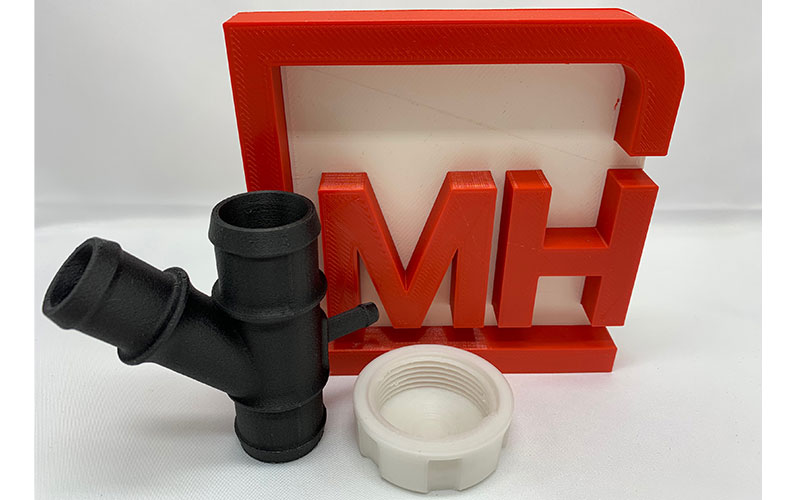by Lara Copeland, contributing writer, Plastics Business
Additive manufacturing has been on the scene for more than three decades. As a constantly evolving industry, the technology has expanded its applications beyond its common use for jigs and fixtures and is growing more significant to other plastics processing uses. Plastics Business spoke with Haleyanne Freedman, engineering market manager at M. Holland, headquartered in Northbrook, Illinois, about what is in store for the industry and how 3D printing can influence excellence in molding.
Why has additive manufacturing experienced accelerated growth as a result of the pandemic?
Honestly, visibility played a big part. A couple days after the world shut down in March 2020, suddenly 3D printing was in every publication and on the news – making face shields, making masks, etc. Historically, it has been incredibly difficult for companies to identify where 3D printing fits, and that’s why we must show people every day where it makes sense within their facilities – they need to understand the value proposition. When the world’s supply chain failed, 3D printing was able to step in, help save a lot of lives and make a big difference. Everyone saw what 3D printing is capable of and what it can be used for, in a way that wasn’t typical.
It’s not a process that is going to completely overtake injection molding – that’s not realistic. And, 3D printing fits best in small volumes and in production applications. But, I think it finally got the recognition that it needed – in the mainstream and among other manufacturers that might have been more closed-minded – to show how it can be utilized as an effective technology.
For what applications are 3D printing/additive manufacturing being used?
Everyone knows about prototyping and jigs and fixtures. Those have been beaten to death in terms of applications, but the production applications that are starting to become more significant have been low-volume custom molding applications. There are planes flying around with 3D-printed parts in them today. It’s used for a lot of very specific things, but it also is a broadly applicable technology. We uncover new applications almost daily for 3D printing, and we really see it being big in plastic manufacturing overall.
What’s next for the industry?
The industry is unique in the sense that it advances very, very quickly. It’s kind of comparable to technology in that sense – new things always are coming out. Printers are getting better and faster. Materials are getting better, less expensive and more attainable. Material developments have been quite significant in additive manufacturing in the last year, especially in filamentized printing, but there still is work to do.
The 3D printers aren’t necessarily as good as they’re going to get, but the materials are not catching up to the machine platforms. With closed-source not really making much sense anymore, it’s encouraging a lot of material manufacturers to invest more resources into research and development on new compounds and materials that are making a difference for the industry – and that can be used with a variety of platforms. Prior to these open-platform advancements, there were a handful of materials that were compatible with closed platforms, but that technology is obsoleting because of that limitation.
How can 3D printing be used to increase efficiency or quality in plastics molding operations?
It is important for us to represent 3D printing as the production-capable technology that it is. However, the answer has to be “effective and functional prototyping.”
The prototypes used to see how big the part will be are important and necessary, but not groundbreaking. It’s not saving weeks of time or anything like that, but it does help decrease the time to market. 3D printing also helps when fast replacements need to be subbed in – for example, we are experiencing a plastics crisis right now, and we can’t get material we need. 3D printing is a simple and completely reliable solution that can reduce the impact of the resin supply shortage.
3D printing hasn’t been viewed as price competitive with traditional molding for larger volumes. Is that changing?
That’s actually not true. It depends on how “larger volume” is classified, and this supply shortage is a great example. Polypropylene has insane per-pound costs, and we’ve actually had a couple of recent cases where 3D printing has beat injection molding cost. And, that’s a first. It blew my mind. I thought we’d come in as more expensive – but not too much more expensive – and we came in under the injection molding cost.
I know that’s not sustainable, and polypropylene prices are going to go back down, but 3D printing is not intended to come in and make five million parts. That’s not what it’s for, and it’s not even what the industry is trying to get to. Instead, the industry is trying to get to a point where we can manufacture 250,000 parts with a cost-competitive advantage on injection molding, because that’s what we would consider low volume. When production gets into the millions of parts, it’s never going to make sense. It’s a niche technology with specific applications and specific fits where it can save hundreds and thousands of dollars for plants.
What are the best opportunities for traditional injection molding companies to use 3D printing in their operations?
As far as application opportunities, the easiest one that’s most widely applicable is jigs and fixtures. When we’re just talking to a company about how to get a printer, prove out the value and start to see some element in cost savings, it’s jigs and fixtures. It’s a starter application where operators don’t have to know everything about the way filamentized material is processed or how to make that a better product. But ultimately, where everyone wants to get to – where it’s going to save hundreds of thousands – is in those low-volume production applications and in the exploration of hybrid product development. Hybrid product development is designing a product that can be both injection molded and 3D printed, and that enables companies to launch a product with very little risk.
As an example, we have a customer who was developing an aftermarket consumer product for a vehicle. The customer wasn’t sure how successful it was going to be, so the company wanted to launch it in smaller quantities and do a test – but a test mold is the same cost as a normal mold. It was going to be incredibly expensive for them to launch it. But, if the product was designed for both 3D printing and injection molding, it could be 3D-printed until it no longer makes sense from a volume standpoint. Not only does that speed up product development, but it also launches more products into the marketplace to find the true fit for the customer’s facility.
How can traditional injection molding companies use 3D printing technology to expand their customer base?
I think that using the technology to diversify business offerings to existing customers is almost a better approach than focusing on new customers, but that still is expansion of business. We’ve seen circumstances where we have lost pellet distribution opportunities on the plastic injection molding side because it no longer made sense, but the customer moved to 3D printing, so we didn’t lose anything.
Plastics processors have to evolve their processes and keep up with the advancements. When customers have those applications that make sense for 3D printing, if their existing processor can’t produce them, they’re going to lose the job. Companies won’t suddenly buy a 3D printer and have all these customers who want to make a purchase, but it is a service that is becoming nearly necessary for facilities to have if they want to stay competitive and keep their costs low enough to retain and protect their existing customers.





